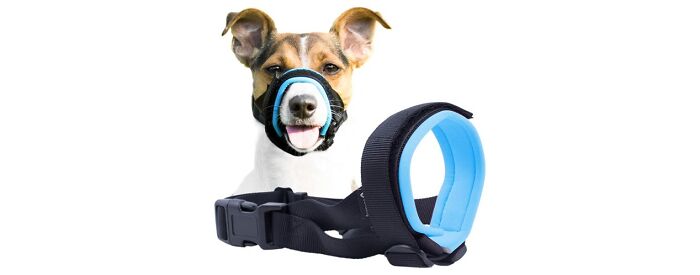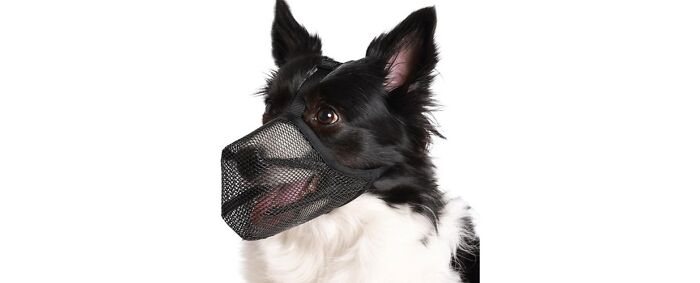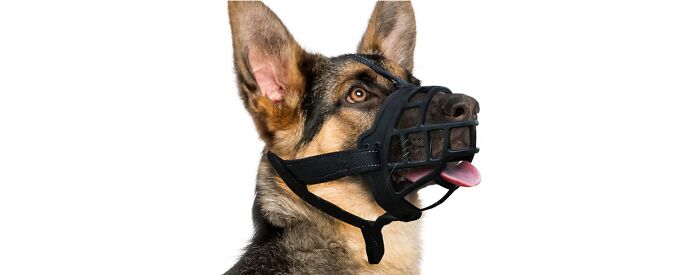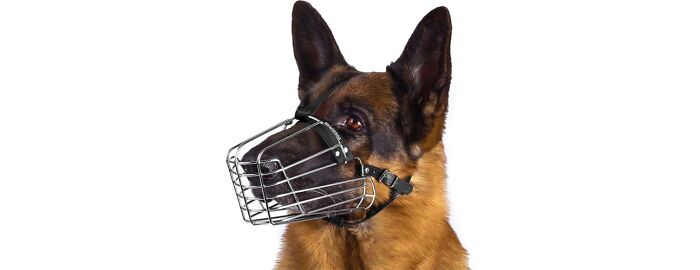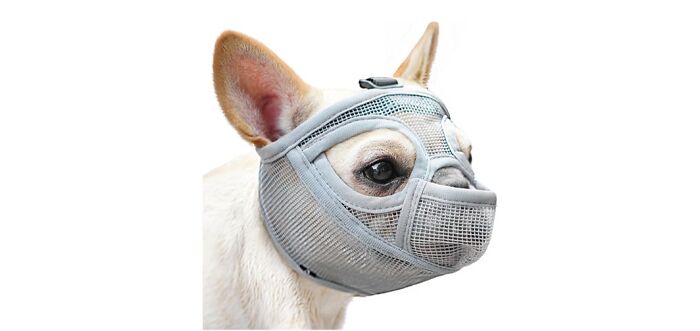We know that using a muzzle may raise some ethical concerns among dog owners, but for some canines, it’s a necessary tool for their safety, health, and those around them. It is a responsible choice, particularly if you have a dog with aggressive tendencies toward other pets or humans.
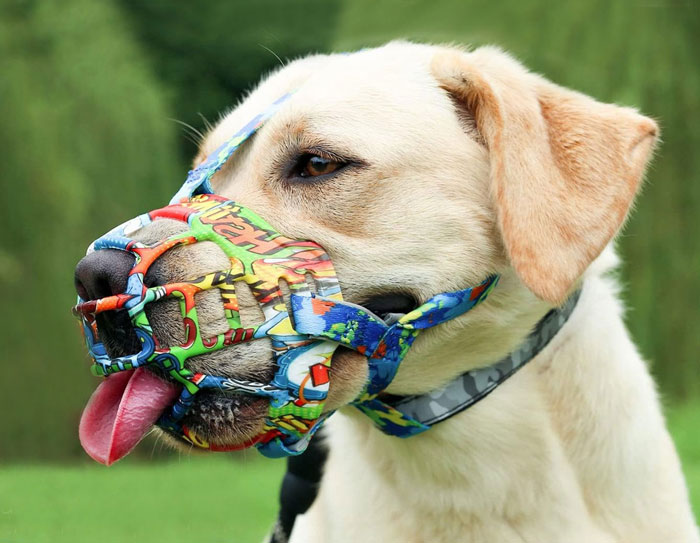
Some canines may have an aversion to the vet, a habit of scavenging unusual food, or simply must undergo training. In such cases, a dog muzzle can be an excellent tool for you and your furry friend.
Bored Panda consulted with Dr. Catharina Hjorth, our veterinary expert, to provide a list of tried-and-tested muzzles for your furry friends. We considered different dog breeds and their unique needs, ranging from the best muzzles for dogs that bite to gentler solutions for smaller, less aggressive canines. Rest assured, most of the muzzles on our list allow your dog to carry out essential daily activities, such as drinking, snacking, and panting, with ease.
The information provided herein is for informational purposes only. Please refer to our disclaimer for more details.
Our Top Picks:
Best Overall: The Barkless Dog Muzzle $19.99
Best Value: Luckypaw Soft Mesh Muzzle $9.99
Best Gentle Muzzle: Goodboy Gentle Muzzle Guard $19.95
Note: All prices and deals listed are accurate at the time of publication. Please check the provided links for the most current pricing.
Best Soft Sleeve Muzzles
Soft-sleeve muzzles are typically made from soft, flexible materials like nylon or rubber. Many dogs find these types of muzzles more comfortable. However, if your dog is very aggressive, they may need a more secure dog muzzle.
This post may include affiliate links.
Goodboy Gentle Muzzle Guard
The GoodBoy muzzle is ideal for pet owners looking for a gentle and secure solution to keep their dogs from biting or chewing unwanted things. Unlike most dog muzzles, it doesn't cover the whole snout, which makes it easier for the dog to breathe comfortably, drink water, or even eat a few occasional treats.
The adjustable strap of the muzzle allows you to customize the snout to your dog’s mouth, ensuring a comfortable and secure fit. It even comes with an additional loop for those dogs who may take some extra time to get used to it.
What we like:
• Very gentle and comfortable
• Allows for natural behavior like panting and drinking
What we don't like:
• It may not provide sufficient protection for stronger dogs
• It may loosen up
Luckypaw Soft Mesh Dog Muzzle
The Luckypaw dog muzzle is lightweight and sturdy, made of soft, odorless mesh material. It is comfortable and durable, ensuring a snug fit around your dog’s snout. It’s perfect for various situations, such as grooming, vet visits, nail trimming, and walks.
The muzzle features adjustable straps at the head and neck that keep it securely in place and minimize the risk of slipping or removal. Additionally, the collar loop provides added security when used with a regular collar, ensuring your dog can't easily remove it. You can easily fold and stash it in your pocket when not in use.
What we like:
• Lightweight yet sturdy
• Available in different sizes
What we don't like:
• Your dog won't be able to drink or eat while wearing it
Best Basket Muzzles
As the name suggests, basket muzzles are shaped like baskets and often made from sturdy materials, making them unlikely to bend or break. In most cases, they are breathable, allowing the dog to drink and receive small treats.
The Barkless Dog Muzzle
The Barkless muzzle is an innovative basket muzzle made of soft silicone, prioritizing comfort and safety. Unlike traditional basket muzzles, it features a neoprene liner that prevents rubbing against the dog’s nose.
The ergonomic design of the Barkless muzzle will prevent your dog from biting or eating things while engaged in various activities, such as walks, interacting with other animals, or visiting the vet. Plus, your dog can have an occasional treat, drink, and pant freely while wearing it.
The muzzle has two safety loops that can be securely attached to your dog’s collar, making it more stable and less likely to be pulled off by unruly paws. Meanwhile, adjustable straps around the neck and head provide a personalized fit for your canine friend.
What we like:
• Neoprene liner prevents rubbing against the dog’s nose
• The dog can drink while wearing it
What we don't like:
• Some dogs may find it overly restrictive
• If your dog is powerful, you may need to consider a more sturdy option
BRONZEDOG Wire Dog Muzzle
The BRONZEDOG muzzle is a dependable and comfy solution that prioritizes your pet’s safety. It is crafted with durable, lightweight steel and features soft neoprene padding to ensure your dog’s comfort. The adjustable leather straps have multiple holes, providing a customized fit and firmly securing the muzzle around your dog’s head for stability.
This basket muzzle is designed to be friendly for dogs, allowing them to easily pant and drink. It is made of sturdy construction that ensures long-lasting protection. The muzzle’s basket shape prevents biting or ingesting harmful objects, allowing for excellent ventilation.
What we like:
• Best muzzle for aggressive dogs
• Suitable for large and strong dogs
• Durable materials
• Great value
What we don't like:
• It will fit perfectly for a limited number of dogs
Best Dog Muzzles for Short-Snouted Dogs
Short-snouted dog muzzles are made specifically for dogs with little or no noses, like French Bulldogs and pugs, sometimes called brachycephalic breeds.
Important: We don't recommend muzzling flat-nosed breeds without consulting a veterinarian to ensure their health and safety.
Mayerson Short Snout Muzzle
The Mayerson short snout muzzle is designed for flat-nosed breeds such as Pugs, Shih Tzus, and French Bulldogs. The muzzle has a mesh pocket to allow your dog’s tongue to hang out freely, promoting natural panting and breathing.
The muzzle also features eyeholes that provide unobstructed vision and a lightweight, breathable mesh that prevents overheating. Most dogs can still eat treats and drink water while wearing the Mayerson muzzle. Plus, it’s available in five sizes, perfect for several flat-nosed breeds.
What we like:
• Lightweight and breathable design
• Allows for panting or drinking
What we don't like:
• It may cause overheating
• It may still obstruct the airways of some dogs
When To Use a Dog Muzzle?
While few dogs love wearing a muzzle, it can sometimes become an invaluable tool during training—and, for some dogs, it helps to keep them healthy and safe. Before employing a muzzle, seek advice from a veterinarian or a professional dog trainer to ensure maximum benefits.
Wear the Muzzle in Emergencies
If a dog is injured or otherwise in distress, it is part of their nature to bite to protect themselves, especially if their owners are nearby. During some medical procedures or when moving the dog to safety or medical assistance, it may be necessary to use a muzzle to ensure the safety of all personnel involved.
When There’s a Risk of Aggression
Some dogs are more prone to aggressive behavior than others. It is unlikely to be the dog’s fault; something may have happened in the past that will likely cause it to become scared and aggressive in certain situations. But, if the dog is known to be at risk of biting, we advise using a muzzle to protect the dog and other nearby animals and humans.
During Grooming Sessions
Not all dogs love going to the groomers. If it’s the case with your furry companion, a muzzle may be the best solution to ensure the groomer and dog are safe through the grooming procedure.
Compliance with Legislation
In some countries and areas, it is mandatory by law for all or some dogs to wear a muzzle. Make sure to follow these rules to avoid fines or similar complications.
For Health Reasons
If your dog has a habit of eating everything in sight outdoors, this can lead to gastrointestinal issues, poisoning, or even the risk of a foreign object getting stuck in their body. In such cases, using a dog muzzle can be a wise choice to protect the health and safety of your canine friend.
Why Do Dog Muzzle Spark Debates?
Dog muzzles have long been debated among dog owners, trainers, and professionals, sparking discussions about their necessity, effectiveness, and ethical implications. The debate regarding dog muzzles tends to range from concerns about their impact on a dog’s well-being to their role in managing aggressive behavior.
Link with Aggression
One of the main reasons muzzles have a bad rep among dog owners is that many people associate muzzles with aggression. As a result, dogs wearing muzzles are often stigmatized and misunderstood, and their owners may hesitate to use them to manage their pet’s behavior. This association can cause misconceptions about the use of muzzles and lead to dog owners’ reluctance to consider them a viable option.
The Overwhelming Variety of Muzzles
The dog muzzle market offers a wide variety of options, which can lead to confusion for dog owners. There are many types of muzzles available, such as basket muzzles, wire basket muzzles, leather basket muzzles, and mesh muzzles. Each type has its features and benefits, making it difficult for owners to choose the fitting muzzle for their dog’s needs.
Lack of Freedom
Muzzles that don't fit well or are poorly designed can cause discomfort to dogs, limit their ability to pant or drink, and even lead to injuries or worsen behavioral problems. This highlights the significance of choosing the proper muzzle for your dog and ensuring it fits correctly when you put it on.
Mixed Opinions on Dog Training
The topic of muzzles is often discussed in relation to dog training. Some dog trainers and behavioralists believe that muzzles can be helpful as a temporary measure to manage aggressive behavior or to prevent biting. However, others argue that muzzles may not address the root causes of aggression and could even exacerbate behavioral issues if they aren't used appropriately.
When Should You Not Use a Muzzle?
While muzzles can be valuable tools in certain situations, there are instances where you should keep your dog muzzle-free, as well as some dogs where they aren't suitable. Owners must understand when a muzzle is proper and when it is crucial to avoid it to ensure the safety and well-being of their canine companions.
When Your Dog Has Underlying Behavioral Issues
A dog muzzle should never be a substitute for addressing any underlying behavioral issues that your furry friend might have, such as fear or anxiety. If your dog is growling, lunging, or biting, it’s not enough to just muzzle them without addressing the root cause of the problem. Instead, we recommend seeking advice from a professional dog trainer to help you address these behavioral issues safely and effectively.
As a Form of Punishment
Dog muzzles should not, similarly, be used to punish or control a dog. They are suitable for preventing a dog from eating unwanted items or biting, but misusing the muzzle might trigger a negative response in your dog. Proper training is critical to avoid unnecessary anxiety and discomfort.
If a Muzzle Doesn’t Fit Properly
Dog muzzles should not be used if they don't fit properly or restrict a dog’s breathing. This can worsen pre-existing health issues.
Fitting Guide for a Dog Muzzle
Properly fitting a muzzle is essential for ensuring the comfort and safety of your dog and the people around them. Here’s a step-by-step guide on how to fit a muzzle correctly.
Measure your dog’s snout. Use a flexible tape measure to measure the circumference of your dog’s snout near the base of its nose. Then, measure the length of its snout from the tip of its nose to the point where it meets its face.
Select the appropriate type of muzzle. Various types are available, including basket muzzles, soft sleeve muzzles, and mesh muzzles. Consider your dog’s breed, size, and specific needs when choosing the best muzzle.
Introduce the muzzle calmly. It is essential to let your dog sniff and investigate the muzzle before trying to put it on. Once your dog is comfortable near the muzzle, hold the muzzle open and place it over your dog’s snout, positioning the straps correctly.
The muzzle should fit snugly. Fasten the straps securely, adjusting the straps as needed to ensure a comfortable and secure fit. Make sure the muzzle doesn't rub or chafe your dog’s skin. You should be able to fit one finger between the muzzle and your dog’s snout.
Monitor their behavior. If you see signs of discomfort, need help fitting a muzzle, or encounter any difficulties, feel free to seek help from a professional dog trainer or veterinarian. They can guide and assist to ensure the muzzle is fitted correctly and meets your dog’s needs.
FAQ
What is the most humane muzzle?
A humane muzzle should allow your dog to breathe, drink, and pant comfortably. Soft muzzles, like mesh or leather basket muzzles, are good options that are less restrictive. Adjustable straps and padded linings help ensure a proper fit.
What type of muzzle stops scavenging dogs?
Fully covered snout muzzles prevent dogs from scavenging harmful objects. Mesh muzzles with a secure fit allow dogs to breathe and pant freely. Remember always to supervise your dog closely when wearing a muzzle.
Can a dog still hurt you with a muzzle?
Muzzles can reduce the risk of dog bites, but they don't eliminate the risk entirely. Even while wearing a muzzle, a dog may still be able to cause minor injuries. Always use caution when handling a muzzled dog, and remember that muzzles aren't a substitute for proper training and behavior modification.
Are muzzles only for aggressive dogs?
Muzzles aren't just for aggressive dogs. They can also prevent scavenging, control barking, or reduce stress during vet visits or grooming sessions. Some breeds may be required to wear muzzles due to breed-specific legislation or for safety reasons. However, muzzles should only be used if properly fitted and with proper training and behavior modification techniques.
I don’t really understand why people downvoted this list besides the obvious “oh we don’t want a list of advertisements” which is understandable. If you’re all anti-muzzle about this list just keep in mind these muzzles were reviewed by vets, and weigh the pros and cons.
I don’t really understand why people downvoted this list besides the obvious “oh we don’t want a list of advertisements” which is understandable. If you’re all anti-muzzle about this list just keep in mind these muzzles were reviewed by vets, and weigh the pros and cons.

